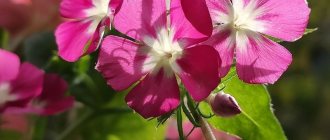First steps
Every business has its own characteristics, and floriculture is no exception. What flowers should I plant on the balcony and what do I need to create a flower garden?
So, it’s better to start arranging with repairs. It is not necessary to do a general rearrangement and renovation of the entire balcony area; it is quite enough to paint the railings or replace the flooring if the situation requires it. After this, you need to decide on the shade of colors that will fill the space. Ideally, flowers on the balcony should not blend in with the color of the walls.
You should immediately decide whether you will grow plants only for yourself, or whether you want passersby to admire your work. In any case, it is important to remember that the permissible load on the balcony must not be exceeded. Therefore, you should not chase the number of pots; it is better to give preference to a design that will allow you to create the perfect flower arrangement.
When placing flowers on the balcony, it is recommended to adhere to the general rules for designing such an area, as well as to correctly select the types of flowers, flower pots, and boxes.
Design rules
If the balcony is large, then you can combine any greenery on it. It can be ceiling-mounted, vertical or horizontal. Flower arrangements on the balcony made up of camellias, lilies and peonies look great. You can decorate the area with a lawn, pebbles, a miniature pond or a waterfall. The only limitation here is your imagination. When decorating, it is advisable to use all zones: walls, ceiling, fence, floor.
On small balconies, horizontal landscaping is usually used. To do this, balcony boxes in which flowers are grown are hung from the outside of the fences. Large boxes and pots are arranged along the walls. They can accommodate large indoor flowers - on the balcony they will grow better and delight with their beauty. Garden plants are chosen for balcony boxes: carnations, petunia, calibrachoa, surfinia, pelargonium, marigolds and other types of plants. Each species has its own growing characteristics.
During arrangement, do not forget about convenience: there should be easy access to pots and drawers.
It is recommended to decorate small balconies with vertical types of plants. Containers with flowers are placed on the walls, ceiling, and floor. Be sure to provide ladders or ropes, trellises along which climbing flowers can quickly climb up, turning the balcony into an elegant corner of paradise. For vertical gardening, you can use virgin grapes, beans, sweet peas, morning glory, nasturtium and other types of climbing plants.
You can plant flowers on the balcony in boxes, flower pots, and pots. When choosing a container, it is important to consider their volume: the plants must have enough space for normal development and growth.
Sunny side
Select flowers for a balcony on the sunny side that love direct sunlight and are able to withstand high temperatures. These can be bright balcony mixtures, herbs, everyone’s favorite petunia and many other plants. What flowers are most often placed on the balcony?
There are several recommendations for placing flowers on southern balconies:
- For decoration you can use morning glory, petunia, viola, verbena, purslane.
- Begonia grows well on the sunny side. A large selection of colors allows you to create unusual compositions. Unlike some other plants, begonia blooms profusely until frost and has beautiful foliage. It is often grown as a main plant. As a complement, small-flowered species such as lobelia are planted.
- Among the sets for southern balconies, preference is often given to daisies, heliotrope and asters, balsams, and zinnias. The latter are among the most unpretentious plants.
- You can create a miniature vegetable garden on the balcony. Nowadays, many varieties of vegetables have been developed for growing on balconies. Tomatoes, cucumbers, herbs, and herbs are suitable for a home garden. On the south side you can grow sage, coriander, and mint.
- An excellent solution is to grow climbing plants. Among the vertical varieties, preference is given to morning glory and sweet pea.
When deciding which flowers are best to grow on the sunny side of the balcony, you should immediately decide how they will be located. If the space allows, then you can think about a combination of flowers and vegetables. For example, you can grow vegetables on the floor and in boxes as horizontal gardening: eggplants, tomatoes. Hanging flowerpots with petunias can be installed under the ceiling. It is recommended to plant climbing flowers near the wall and give them the opportunity to weave along the railing.
To the cardinal points
The side on which the loggia faces is of no small importance for cultivation: some species get along well in the shade, others prefer the sun.
Northern
Shade-loving varieties feel best on the northern balcony.
Cyclamen
It can grow and, most importantly, bloom without light! Unusual buds and colorful leaves will decorate any shaded balcony.
Fern
If you value beautiful greenery more than buds, take a closer look at ferns! Gorgeous lush bushes feel great in the shade.
Hydrangea
A luxurious flower with large clusters of inflorescences is an ideal choice for a spacious loggia on the north side. For hydrangea to feel good, watering is more important than sun exposure.
Calceolaria
It is considered capricious, but those who can provide comfortable conditions will be rewarded with lush flowering.
Primrose
An interesting perennial that is not afraid of shade - the main thing is to loosen and water the soil in time.
South
In the south, on the contrary, plants that love the sun will take root - unsuitable species will burn and get burned.
Gaillardia
Grows in any conditions, is not afraid of wind in open loggias.
Succulents
There are many species that are accustomed to the sun: when exposed to direct rays, they will change the color of their leaves to orange or red and become like flowers.
Maiden grapes
A fast-growing bindweed for those who want to shade a balcony. In order for the vines to curl in the right direction, you will need a trellis or rope.
sedum
An unpretentious ground cover plant is more often found in the garden, but it will also look appropriate in a box or pot on the balcony.
Phlox
To enjoy a rich flower harvest, make sure that the roots do not overheat: plant the plant in a light pot.
Western and Eastern
Snapdragon
I’m not picky about lighting, but it doesn’t like the wind: so it’s better to grow it on glassed-in loggias.
Clematis
More suitable for western balconies; it can winter without problems in a warm loggia.
Fragrant herbs
Sage, mint, tarragon, and dill will replace flowers for the eastern balcony.
Balcony in the shade
Balconies located on the lower floors and on the north side are characterized by an excessive amount of shade. Plants grow slowly on them and do not bloom as profusely. When creating a flower garden on a balcony with predominantly shady lighting, preference should be given to balsams, chlorophytum, fuchsias, tradescantia, begonias, ageratum, and marigolds.
The lack of light narrows the choice of plants, but even with this option it is worth adhering to the rule of filling the space with light. For this purpose, preference is given to white, light-colored plants, which can visually smooth out the gloom of dark balconies.
Plants for vertical gardening
Canopy plants are light-loving and shade-tolerant. They can be flowering or green. This should be taken into account when choosing this type of plant. Ampelous species can be grown in hanging pots, in balcony boxes, flowerpots, and flowerpots. The landing container should be light. It is hung so that it does not press close to the wall.
Lobelia is used for vertical gardening. This is an ideal plant, creating a beautiful cascade of branches covered with small flowers.
Among the climbing plants, Echinocystis lobes is suitable for the balcony. This is an unpretentious climbing plant that is grown on balconies with any degree of lighting. The plant has large leaves and blooms with small white flowers with a light honey aroma.
Decorative bindweeds are used for horizontal decoration. They are decorated with gramophones of various colors. For landscaping, you can use field, blue, pink bindweed and other plants that will help create the ideal composition.
Morning glory looks no less elegant. This plant comes in a wide variety of varieties with different colors. Moreover, they differ not only in shape and color, but also in size. Morning glory blooms from May to September.
For sunny balconies, the ideal solution would be to grow ampelous or cascading petunia. This flower differs from other plants in its unpretentiousness, resistance to rain and wind.
Green balcony
To create a green corner (for example, as shown in the photo above), only those flowers that do not have inflorescences and always remain green are planted on the balcony.
Green boxwood is used to decorate borders. This is an evergreen shrub, from which real masterpieces are often created in gardens. In balcony conditions, boxwood must be trimmed periodically to prevent it from growing.
On the sunny side you can grow thuja and juniper. These conifers grow slowly and do not need frequent replanting, but are demanding when it comes to feeding. The plants have a flexible crown that allows you to simulate real masterpieces. The upper part tolerates frost well, but it is best to wrap the pots for the winter to prevent the root system from freezing.
The balcony is an ideal place for growing dwarf pines. From them you can create a real bonsai nursery.
Lobelia
Lobelia Crystal Palace / ontheedgegardening.wordpress.com
- Where to put: on a bright northern, eastern or western balcony; and on the south side, shade the plant and do not leave it under the scorching sun.
- When it blooms: from early summer to autumn.
- How long does it live: Usually grown as an annual.
On the balcony you can plant both bush and hanging lobelia. It blooms profusely and magnificently. The buds themselves are small, blue, blue, violet or purple.
Water the lobelia moderately, once every two to three days. More often during hot periods, especially on glazed balconies. The earth should neither dry out nor become swampy.
Place it on the windowsill











